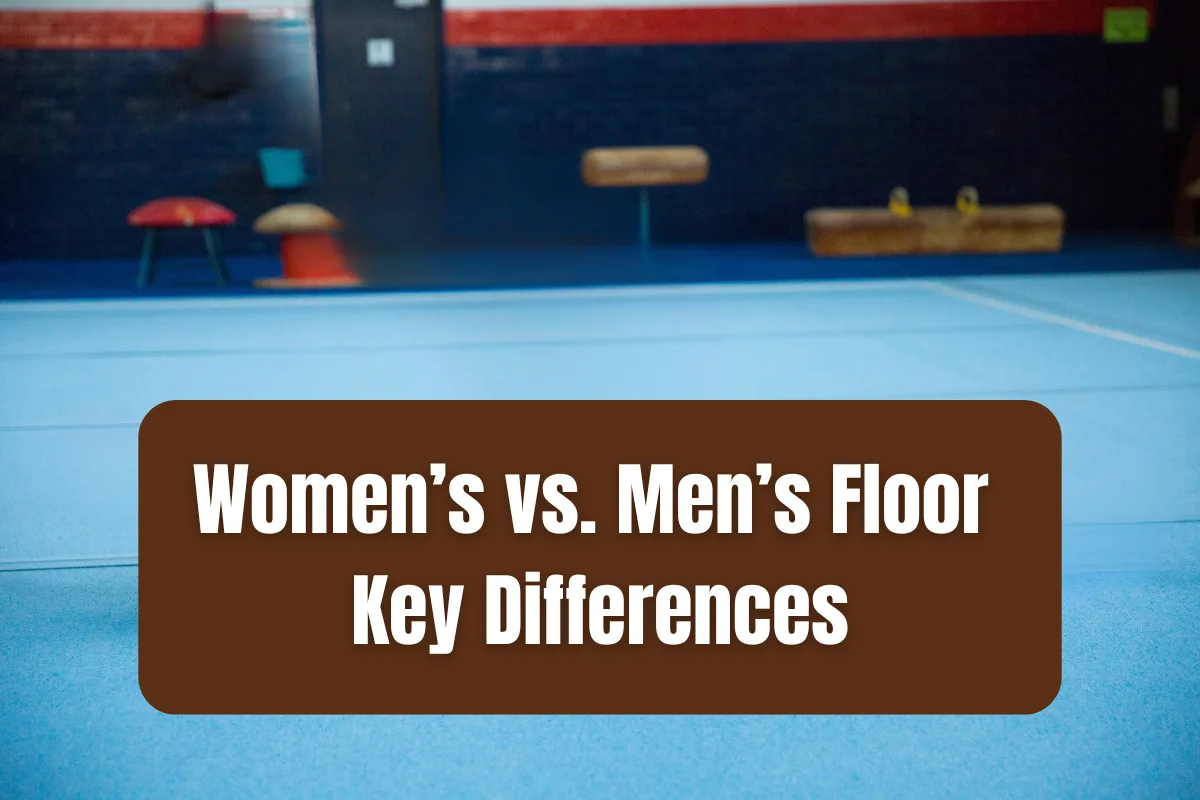Floor exercise is the only event in artistic gymnastics where both men and women compete on the same apparatus. But if you watch closely, you’ll notice that their routines are very different in style, structure, and purpose.
The Apparatus: Same Size, Same Surface
Both women’s and men’s floor routines take place on a 12 m x 12 m (39 ft x 39 ft) spring floor, surrounded by a 1 m safety border. The surface is built with foam and springs to:
- Help gymnasts generate lift for tumbling passes
- Absorb the force of landings to reduce injury
While the equipment is identical, the way gymnasts use the space is not:
- WAG (Women’s Artistic Gymnastics): The floor is filled with choreography, leaps, expressive transitions, and tumbling.
- MAG (Men’s Artistic Gymnastics): The floor is used efficiently for tumbling lines, strength holds, and directional variety.
Here’s a closer look at the key differences.
1. Music & Artistic Expression
In women’s floor, music is required. Routines are choreographed to match the rhythm and mood of the piece, blending tumbling with leaps, turns, and expressive movements. Judges also score artistry, looking for emotion, style, and how well the gymnast connects with the music.
- Music required (instrumental only in FIG/USAG; NCAA allows lyrics)
- Artistry and choreography are judged
- Movements must reflect the music’s character
In men’s floor, there is no music at all. Routines are performed in silence, and artistry is not judged. Instead, the focus is purely on tumbling difficulty, strength holds, and clean execution.
- No music allowed
- No artistry deductions
- Focus is entirely on skills and control
In short: Women’s floor is part performance, part gymnastics. Men’s floor is all about athletic skill.
2. Duration & Structure
Women’s routines last between 1:00 and 1:30 minutes. They include two or three tumbling passes plus leaps, turns, and dance choreography that covers the full 12×12 floor.
Men’s routines are shorter—up to 70 seconds under FIG rules. With no dance sections, men usually perform four to five tumbling passes plus required strength or balance elements like handstands and planches.
- Women: 1:00–1:30 minutes, tumbling + dance + artistry
- Men: Up to 70 seconds, tumbling + strength holds
- Women balance artistry with acrobatics; men pack in more passes
3. Required Skills & Composition
Women’s floor routines must combine tumbling and dance. The Code of Points requires:
- At least three acrobatic elements (one must be a salto)
- A dance passage connecting leaps or jumps
- One turn of at least 360° on one foot
Men’s floor routines must demonstrate tumbling in all directions—forward, backward, sideways, and twisting. They also require:
- At least one double salto
- Strength and balance elements (press handstands, planches, etc.)
- Tumbling variety without excessive repetition
- Women: Tumbling + leaps + turns + dance passage
- Men: Tumbling in multiple directions + strength holds
4. Purpose & Presentation
Women’s floor is as much about performance as it is about acrobatics. Judges reward originality, musical interpretation, and personality. Expression and artistry can make the difference between a solid routine and a standout one.
Men’s floor has no performance requirement. Presentation is judged only in terms of confidence and control. Judges are focused on clean landings, strong shapes, and the ability to maintain stamina over several tumbling passes.
- Women: Storytelling and artistry matter
- Men: Execution and power are the priority
5. Historical & Cultural Roots
The differences come from history. Men’s gymnastics evolved out of military training in the 19th century, emphasizing strength, discipline, and endurance. Women’s gymnastics developed later, with roots in ballet and dance, which introduced music, rhythm, and artistry. Those traditions still shape the sport today.
- Men: Military and athletic origins
- Women: Dance and performance origins
| Feature | Women’s Floor | Men’s Floor |
|---|---|---|
| Music | Required; artistry judged | None allowed |
| Duration | 1:00–1:30 minutes | Up to 70 seconds |
| Composition | Tumbling + leaps + turns + dance passages | Tumbling in 4 directions + strength skills |
| Focus | Artistic + expressive | Powerful + technical |
| Origins | Dance and performance traditions | Military/strength traditions |
Example Routine Breakdown
Women’s Floor Routine (General Flow)
- Starting Pose – Strong or expressive shape to match the opening music.
- First Tumbling Pass – A powerful line across the floor.
- Dance Passage – Connected leaps, jumps, and turns in rhythm with the music.
- Second Tumbling Pass – Another big tumbling line, often with twists.
- Artistry Section – Floorwork, expressive gestures, and choreography tied to the music.
- Final Tumbling Pass – The hardest or most dramatic pass, usually near the end.
- Ending Pose – Striking a final shape right on the last note of the music.
Overall: A mix of acrobatics, dance, and expression, performed like a short performance to music.
Men’s Floor Routine (General Flow)
- Opening Sequence – Usually a simple pose or quick setup (no music).
- First Tumbling Pass – Strong acrobatic line, often with multiple flips or twists.
- Strength or Balance Element – Handstand, planche, or press for control.
- Second Tumbling Pass – Another line in a different direction (e.g., front tumbling).
- Transition Skills – Simple steps or rolls to set up the next pass (not choreography).
- Third & Fourth Tumbling Passes – More high-difficulty skills, testing stamina.
- Final Pass & Pose – Last tumbling line, ending with a controlled landing and brief hold.
Overall: A series of tumbling and strength skills, performed in silence with no dance or artistic requirement.
Final Thoughts
Women’s and men’s floor may share the same apparatus, but they tell very different stories. One uses music and choreography to turn gymnastics into a performance; the other strips it down to raw athletic power.
In the end, that’s what makes floor exercise unique, it proves that gymnastics can be both art and athletics, side by side on the very same stage.













